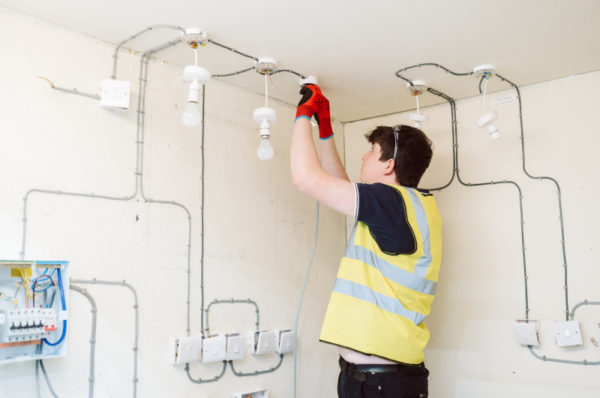Customized BRE Electrical Solutions for Effective and Safe Installations
Customized BRE Electrical Solutions for Effective and Safe Installations
Blog Article
Debunking Electrical Installment: Understanding Codes and Regulations for a Lawful and Safe Configuration
In the realm of electrical installation, adherence to codes and laws is extremely important to ensure both legitimacy and safety. The intricacies bordering electrical work can be challenging, but acquainting oneself with the well-known criteria is crucial to navigating this field with confidence. By understanding the details of the National Electric Code and local building ordinance, individuals can assure that their setups fulfill required precaution and remain in conformity with the regulation. However, the journey to debunking electrical installment exceeds simple familiarity with guidelines; it necessitates an extensive understanding of just how to apply secure electrical practices successfully.
Importance of Electrical Codes
The adherence to electric codes is important in making sure the security and integrity of electric installments. Electric codes function as a collection of standards and standards that dictate the appropriate style, installment, and upkeep of electric systems. These codes are established to decrease the threat of electric dangers, fires, and other safety and security concerns that might arise from malfunctioning electrical job.

Moreover, electrical codes are frequently updated to include brand-new technologies, finest techniques, and precaution. Staying updated with these codes is necessary for specialists in the electrical industry to ensure that their work meets the most up to date security requirements. Inevitably, the significance of electric codes depends on developing a safe and efficient electrical framework that benefits both individuals and neighborhoods.
Key Laws for Security
A number of fundamental guidelines govern the safety and security standards in electrical installments. One key guideline is the National Electric Code (NEC), which gives guidelines for safe electrical style, installation, and examination to protect individuals and residential property from electric dangers. The NEC covers facets such as circuitry methods, grounding, overcurrent security, and equipment installment to ensure a risk-free electric system.
An additional critical law is the Occupational Safety And Security and Wellness Administration (OSHA) standards, which concentrate on the safety and security of employees involved in electric setups (BRE Electrical). OSHA laws consist of demands for correct training, security treatments, and individual safety equipment to stop work environment accidents and injuries
Moreover, the International Electrotechnical Commission (IEC) standards intend to harmonize electrical setup regulations on an international range. These criteria address concerns like electric devices safety and security, electro-magnetic compatibility, and power performance to advertise harmony and safety and security in electrical setups worldwide.
Conformity with these vital guidelines is necessary to ensure the safety and legitimacy of electrical installations, securing both individuals and property from the risks related to electricity.
Understanding National Electric Code
Key laws such as the National Electrical Code (NEC) give important guidelines for risk-free electrical style, installation, and evaluation to make certain the protection of people and property from electric risks. The NEC, also called NFPA 70, is a comprehensive collection of standards for electric setups that are upgraded every three years. It is established by the National Fire Protection Organization (NFPA) and is helpful resources widely embraced throughout the United States.
The NEC covers numerous facets of electrical job, including wiring approaches, grounding, overcurrent protection, and tools setup. more helpful hints It intends to safeguard people and residential or commercial property by resolving potential risks connected with electrical systems. Conformity with the NEC is commonly implemented by neighborhood authorities having territory (AHJs), such as developing code authorities and assessors.
Comprehending the NEC is critical for electrical service providers, developers, and inspectors to guarantee that installations satisfy the essential safety and security needs. By adhering to the NEC guidelines, professionals can assist protect against electric crashes and ensure the integrity of electrical systems in household, business, and commercial settings.
Compliance With Regional Building Ordinance
Understanding and sticking to neighborhood building codes is essential for guaranteeing the security and conformity of electric setups within a specific territory. These codes describe specific demands for electrical setups, such as the kind of electrical wiring to be used, positioning of outlets, basing methods, and tons capabilities.
When it comes to electric installations, failing to comply with neighborhood structure codes can result in significant effects. Non-compliant setups may pose security risks, boost the danger of electrical fires, and lead to pricey penalties or legal issues.
Making Sure Safe Electrical Practices
Exercising stringent adherence to developed security methods is crucial in the field of electrical installations to reduce prospective threats and ensure the well-being of individuals and residential or commercial properties. Safety in electric work includes various elements, starting with the proper training of personnel associated with installation, upkeep, and repair. It is necessary to comply with producer instructions diligently when managing websites electric parts and equipment. Before beginning any type of work, it is imperative to conduct a complete danger evaluation to determine possible threats and carry out preventative actions. Utilizing personal safety tools (PPE) such as protected gloves, shatterproof glass, and non-conductive footwear is non-negotiable to guard versus electrical shocks and arc flashes. Normal equipment assessments, screening, and maintenance routines are vital to identify and fix mistakes before they intensify into security threats. Additionally, adherence to proper lockout-tagout procedures throughout upkeep tasks is important to stop unintended energization of circuits. By prioritizing risk-free techniques, electrical installments can function successfully while lessening the probability of accidents or damages.
Verdict
In conclusion, adherence to electric codes and laws is critical for ensuring the safety and security and validity of electric installations. Comprehending the National Electric Code and conformity with neighborhood building codes are necessary for a safe arrangement. By complying with these standards and exercising risk-free electric practices, individuals can stop prospective threats and make sure the proper performance of their electric systems.
Report this page